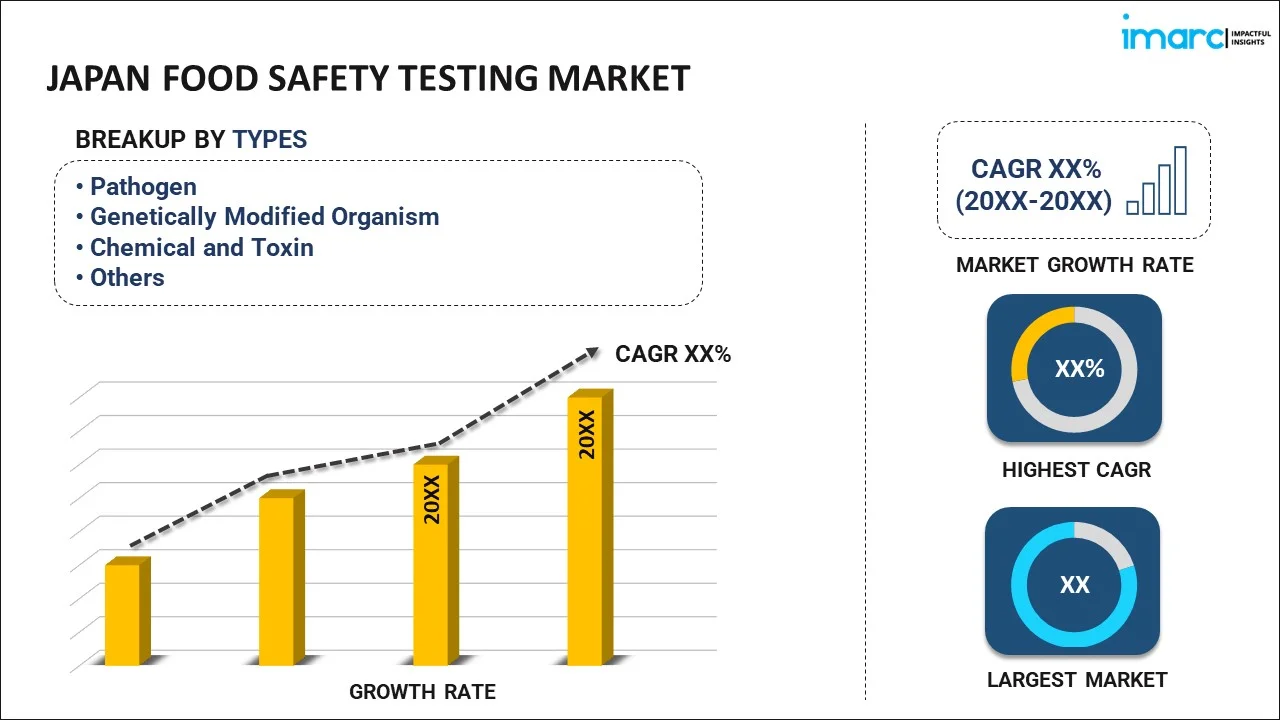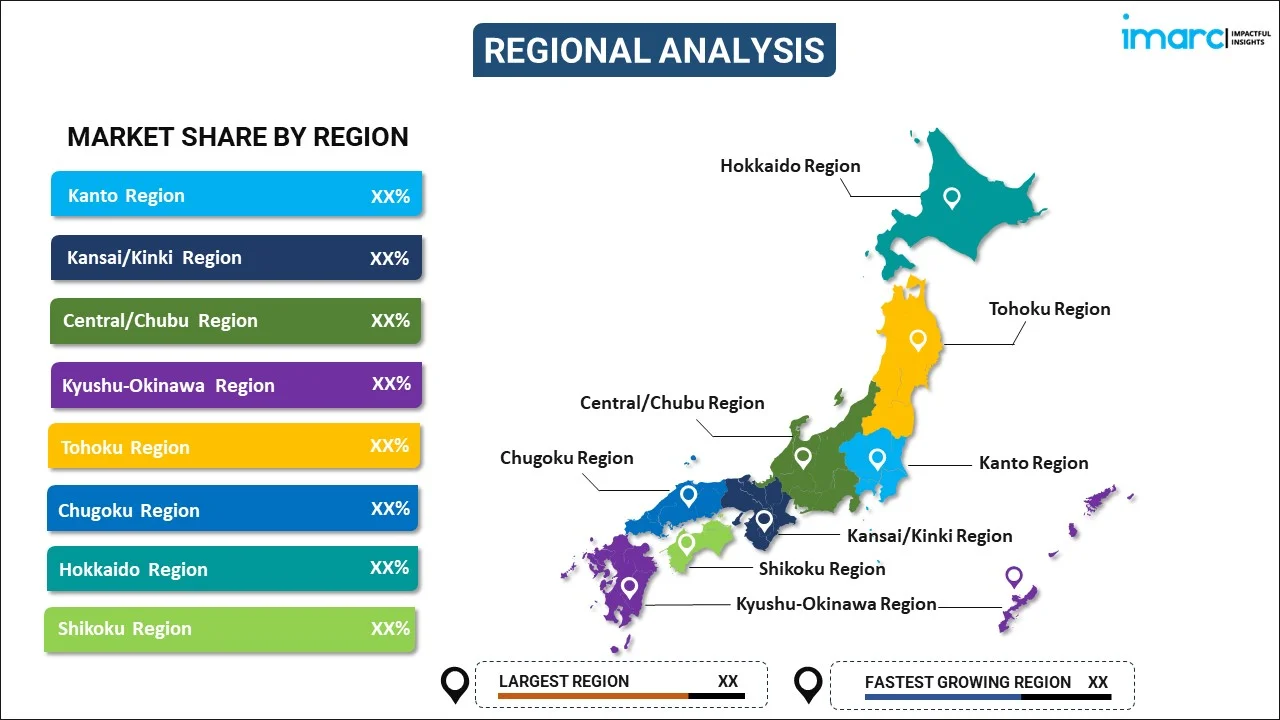
Japan Food Safety Testing Market Report by Type (Pathogen, Genetically Modified Organism, Chemical and Toxin, and Others), Food Tested (Meat and Meat Products, Dairy and Dairy Products, Cereals, Grains and Pulses, Processed Food, and Others), Technology (Agar Culturing, PCR-Based Assay, Immunoassay-Based, and Others), and Region 2025-2033
Market Overview:
Japan food safety testing market size reached USD 945.2 Million in 2024. Looking forward, IMARC Group expects the market to reach USD 1,610.6 Million by 2033, exhibiting a growth rate (CAGR) of 5.8% during 2025-2033. The increasing occurrence of foodborne diseases among the general population, strict government mandates necessitating food producers to adhere to particular food safety criteria, and substantial expansion in the food and beverage sector are among the primary drivers propelling the market forward.
|
Report Attribute
|
Key Statistics
|
|---|---|
|
Base Year
|
2024 |
|
Forecast Years
|
2025-2033 |
|
Historical Years
|
2019-2024
|
| Market Size in 2024 | USD 945.2 Million |
| Market Forecast in 2033 | USD 1,610.6 Million |
| Market Growth Rate (2025-2033) | 5.8% |
Food testing involves the examination of food items to assess their chemical, physical, and microbiological attributes, utilizing a range of analytical methods to guarantee the safety, nutritional value, and superior quality of food products. Its primary function is to identify harmful substances or pathogens present in food, ensuring its suitability for consumption while adhering to regulatory and industry standards. Food testing also ensures accurate labeling of food products, encompassing details about nutritional composition, allergens, and country of origin. Moreover, food testing is instrumental in research and development endeavors, facilitating the creation of new food items, enhancements to existing products, and the assessment of novel ingredients and technologies. Consequently, it serves as a pivotal mechanism in upholding consistent quality in food products, ultimately contributing to improved taste, texture, and overall appearance.
Japan Food Safety Testing Market Trends:
The Japanese food safety testing market is significantly influenced by the heightened strictness of food safety regulations implemented by regulatory bodies in numerous countries, in response to the increasing prevalence of unsatisfactory hygiene practices during food production processes. Consequently, the escalating instances of food adulteration and contamination, leading to potential health risks for consumers, have driven the adoption of more stringent testing procedures. The surge in demand for convenience foods, owing to busy lifestyles and evolving dietary preferences, has resulted in a notable rise in the number of food processing and manufacturing facilities, thereby bolstering the market demand. Furthermore, the continuous advancements in food safety testing technologies, including PCR-based methods, immunoassays, and biosensors, are generating lucrative prospects within the market. Additionally, extensive research and development (R&D) activities, coupled with mergers and acquisitions (M&As), as well as partnerships and collaborations among key market players, are contributing to the overall growth of the market. Factors, including the rapid pace of industrialization, the emerging trend of organic food consumption, and the increasing health consciousness among the population, are anticipated to fuel the market growth over the forecasted period.
Japan Food Safety Testing Market Segmentation:
IMARC Group provides an analysis of the key trends in each segment of the market, along with forecasts at the country level for 2025-2033. Our report has categorized the market based on type, food tested, and technology.
Type Insights:

- Pathogen
- Genetically Modified Organism
- Chemical and Toxin
- Others
The report has provided a detailed breakup and analysis of the market based on the type. This includes pathogen, genetically modified organism, chemical and toxin, and others.
Food Tested Insights:
- Meat and Meat Products
- Dairy and Dairy Products
- Cereals, Grains and Pulses
- Processed Food
- Others
A detailed breakup and analysis of the market based on the food tested have also been provided in the report. This includes meat and meat products, dairy and dairy products, cereals, grains and pulses, processed food, and others.
Technology Insights:
- Agar Culturing
- PCR-Based Assay
- Immunoassay-Based
- Others
The report has provided a detailed breakup and analysis of the market based on the technology. This includes agar culturing, PCR-based assay, immunoassay-based, and others.
Regional Insights:

- Kanto Region
- Kansai/Kinki Region
- Central/ Chubu Region
- Kyushu-Okinawa Region
- Tohoku Region
- Chugoku Region
- Hokkaido Region
- Shikoku Region
The report has also provided a comprehensive analysis of all the major regional markets, which include Kanto Region, Kansai/Kinki Region, Central/ Chubu Region, Kyushu-Okinawa Region, Tohoku Region, Chugoku Region, Hokkaido Region, and Shikoku Region.
Competitive Landscape:
The market research report has also provided a comprehensive analysis of the competitive landscape. Competitive analysis such as market structure, key player positioning, top winning strategies, competitive dashboard, and company evaluation quadrant has been covered in the report. Also, detailed profiles of all major companies have been provided.
Japan Food Safety Testing Market Report Coverage:
| Report Features | Details |
|---|---|
| Base Year of the Analysis | 2024 |
| Historical Period | 2019-2024 |
| Forecast Period | 2025-2033 |
| Units | Million USD |
| Scope of the Report | Exploration of Historical and Forecast Trends, Industry Catalysts and Challenges, Segment-Wise Historical and Predictive Market Assessment:
|
| Types Covered | Pathogen, Genetically Modified Organism, Chemical and Toxin, Others |
| Food Tested Covered | Meat and Meat Products, Dairy and Dairy Products, Cereals, Grains and Pulses, Processed Food, Others |
| Technologies Covered | Agar Culturing, PCR-Based Assay, Immunoassay-Based, Others |
| Regions Covered | Kanto Region, Kansai/Kinki Region, Central/ Chubu Region, Kyushu-Okinawa Region, Tohoku Region, Chugoku Region, Hokkaido Region, Shikoku Region |
| Customization Scope | 10% Free Customization |
| Post-Sale Analyst Support | 10-12 Weeks |
| Delivery Format | PDF and Excel through Email (We can also provide the editable version of the report in PPT/Word format on special request) |
Key Questions Answered in This Report:
- How has the Japan food safety testing market performed so far and how will it perform in the coming years?
- What has been the impact of COVID-19 on the Japan food safety testing market?
- What is the breakup of the Japan food safety testing market on the basis of type?
- What is the breakup of the Japan food safety testing market on the basis of food tested?
- What is the breakup of the Japan food safety testing market on the basis of technology?
- What are the various stages in the value chain of the Japan food safety testing market?
- What are the key driving factors and challenges in the Japan food safety testing?
- What is the structure of the Japan food safety testing market and who are the key players?
- What is the degree of competition in the Japan food safety testing market?
Key Benefits for Stakeholders:
- IMARC’s industry report offers a comprehensive quantitative analysis of various market segments, historical and current market trends, market forecasts, and dynamics of the Japan food safety testing market from 2019-2033.
- The research report provides the latest information on the market drivers, challenges, and opportunities in the Japan food safety testing market.
- Porter's five forces analysis assist stakeholders in assessing the impact of new entrants, competitive rivalry, supplier power, buyer power, and the threat of substitution. It helps stakeholders to analyze the level of competition within the Japan food safety testing industry and its attractiveness.
- Competitive landscape allows stakeholders to understand their competitive environment and provides an insight into the current positions of key players in the market.
Need more help?
- Speak to our experienced analysts for insights on the current market scenarios.
- Include additional segments and countries to customize the report as per your requirement.
- Gain an unparalleled competitive advantage in your domain by understanding how to utilize the report and positively impacting your operations and revenue.
- For further assistance, please connect with our analysts.
 Inquire Before Buying
Inquire Before Buying
 Speak to an Analyst
Speak to an Analyst
 Request Brochure
Request Brochure
 Request Customization
Request Customization




.webp)




.webp)












